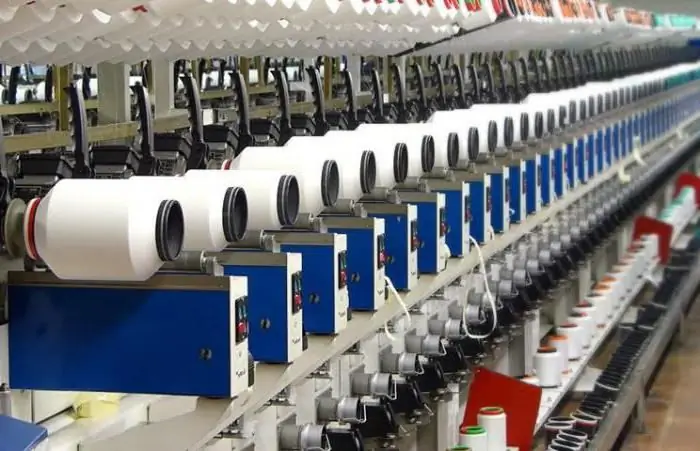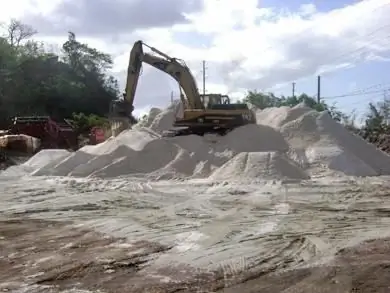2026 Author: Howard Calhoun | [email protected]. Last modified: 2025-01-24 13:10:29
What miracles are not prepared on Earth for man! Here, for example, is an amazing sight - white sand. From afar, you won’t immediately understand: is it snowdrifts in the middle of summer, or mountains of granulated sugar, or maybe table s alt or another chemical? And just approaching, taking it in the palm of your hand and waking up through your fingers, you understand that this is white sand, the photo of which is given in this article. And it consists of quartz - a mineral common on Earth. Quartz is included in the mineral composition of oligomictic and polymictic sands that make up desert dunes, dunes of sea coasts, and shoals of water bodies.

Natural white sand
Deposits of quartz sand are found in river valleys. White river sand is the purest, usually it does not contain pollutants, as well as mountain quartz sand, weathered vein outcrops. It is quite probable to find nuggets of precious metals or their minerals in deposits of natural quartz sand. There is white sand buried under layers of other sedimentary rocks and mined in a quarry. It usually contains pollutants in the form of an admixture of clays, sandy loams,loams, polymictic sands, which are found in the thickness of quartz sands in the form of interlayers and lenses.

Creation of nature and human hands
White sand, composed of 90-95% quartz, is not so common and is highly valued as a raw material for many industries. The lack of natural sand can be filled - to get artificial quartz sand using crushing and screening equipment. For the production of sand, monolithic blocks of milky-white quartz are used, crushing which and sifting the destroyed rock, sand is obtained with certain and desired sizes (fractions) of particles. Artificial sand differs from natural sand in exceptional monomineralism, sharp-angled grains of sand.

Where quartz sand is used
White sand is used to make glass. The following requirements are imposed on it: 95% of it consists of quartz, it must be medium-grained (grain diameter 0.25-0.5 mm), without admixture of substances that are sparingly soluble in the glass mass, without harmful impurities of minerals containing iron, chromium, titanium (they color the glass and increase its light absorption). A good glass sand is one that is 98.5% quartz and includes no more than 0.1% iron oxide.

Quartz glass is needed for the manufacture of chemical glassware, in instrument making - it can withstand significant temperature changes. For molds and cores in the foundryIn the production of ferrous and non-ferrous metals, quartz sand is also used, which is called molding sand in metallurgy. The quality of this sand is determined by its granulometric composition and the shape of the particles that affect the gas permeability, and the amount of impurities that reduce the refractoriness of the sands. It is necessary that the sands do not contain minerals with a high content of sulfur and phosphorus, which are harmful to metal casting. Quartz sand is used for the production of grinding wheels and "sandpaper" - for this sand is melted with graphite and carborundum is obtained, second only to diamond in hardness. The exceptional dirt holding capacity (sorption capacity) of quartz sand is used in filters for water purification from iron and manganese oxides. This sand is used in construction for plastering surfaces and for the production of finishing panels, concrete blocks. Used in landscape design. And even coffee warmed up in a food warmer filled with white quartz sand will delight you with its fragrant taste.
Recommended:
Quartz sand: applications and production

Quartz sand is a material that is of natural origin and has characteristics such as chemical inertness, fracture resistance, strength, and sorption capacity
Loose material (sand, crushed stone): production and sale

Sand and crushed stone are used as bases for various buildings and landscaping, as well as aggregates for concrete
Clothing industry as a branch of light industry. Technologies, equipment and raw materials for the clothing industry

The article is devoted to the clothing industry. The technologies used in this industry, equipment, raw materials, etc. are considered
Dairy industry in Russia. Dairy industry enterprises: development and problems. Dairy and meat industry

In the economy of any state, the role of the food industry is huge. Currently, there are about 25 thousand enterprises in this industry in our country. The share of the food industry in the volume of Russian production is more than 10%. The dairy industry is one of its branches
The strategic natural raw material of the Russian Federation - oil "Urals"

Urals oil is the main export grade of Russian hydrocarbons. The country's budget is directly dependent on oil of this brand, since it is calculated based on the cost of raw materials according to current forecasts of economists

